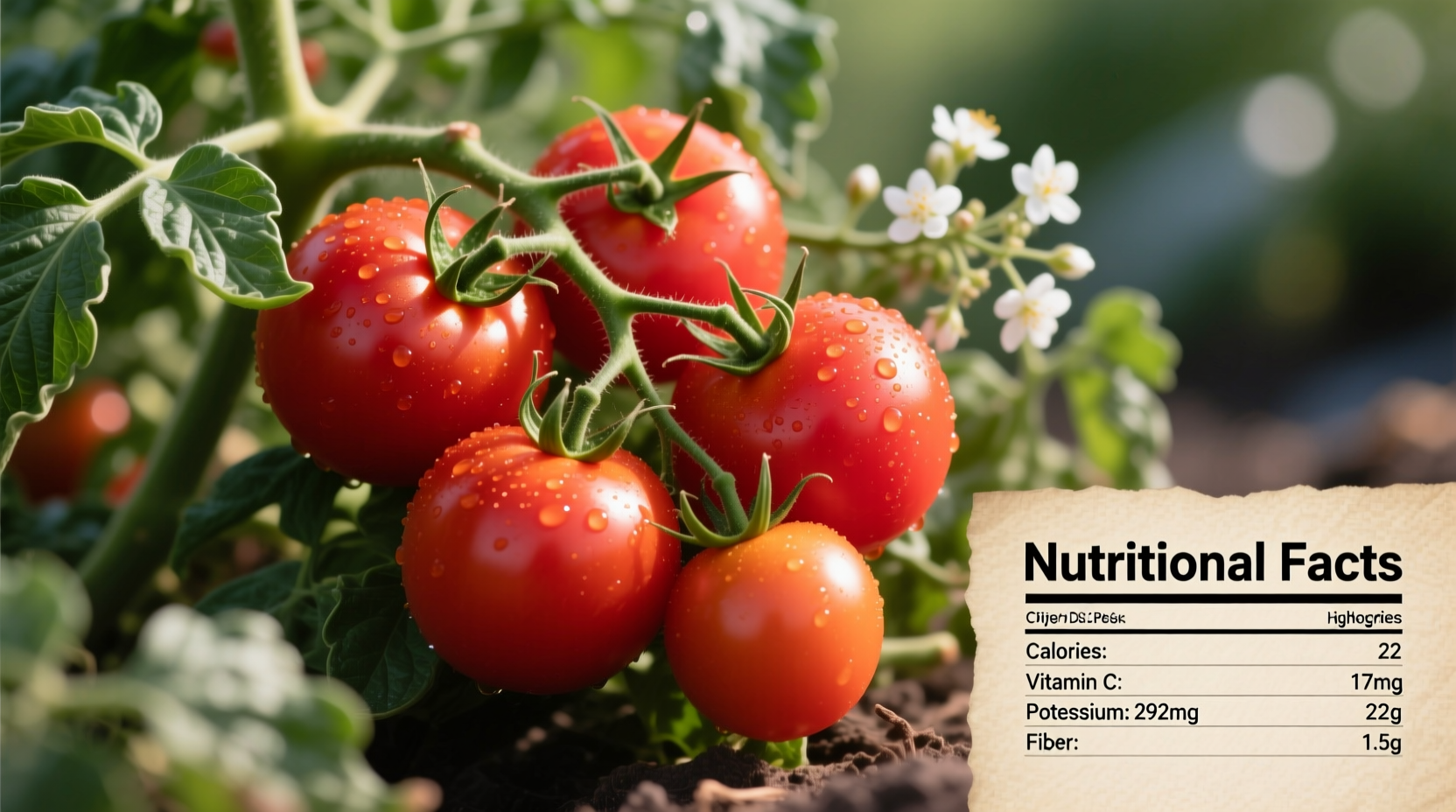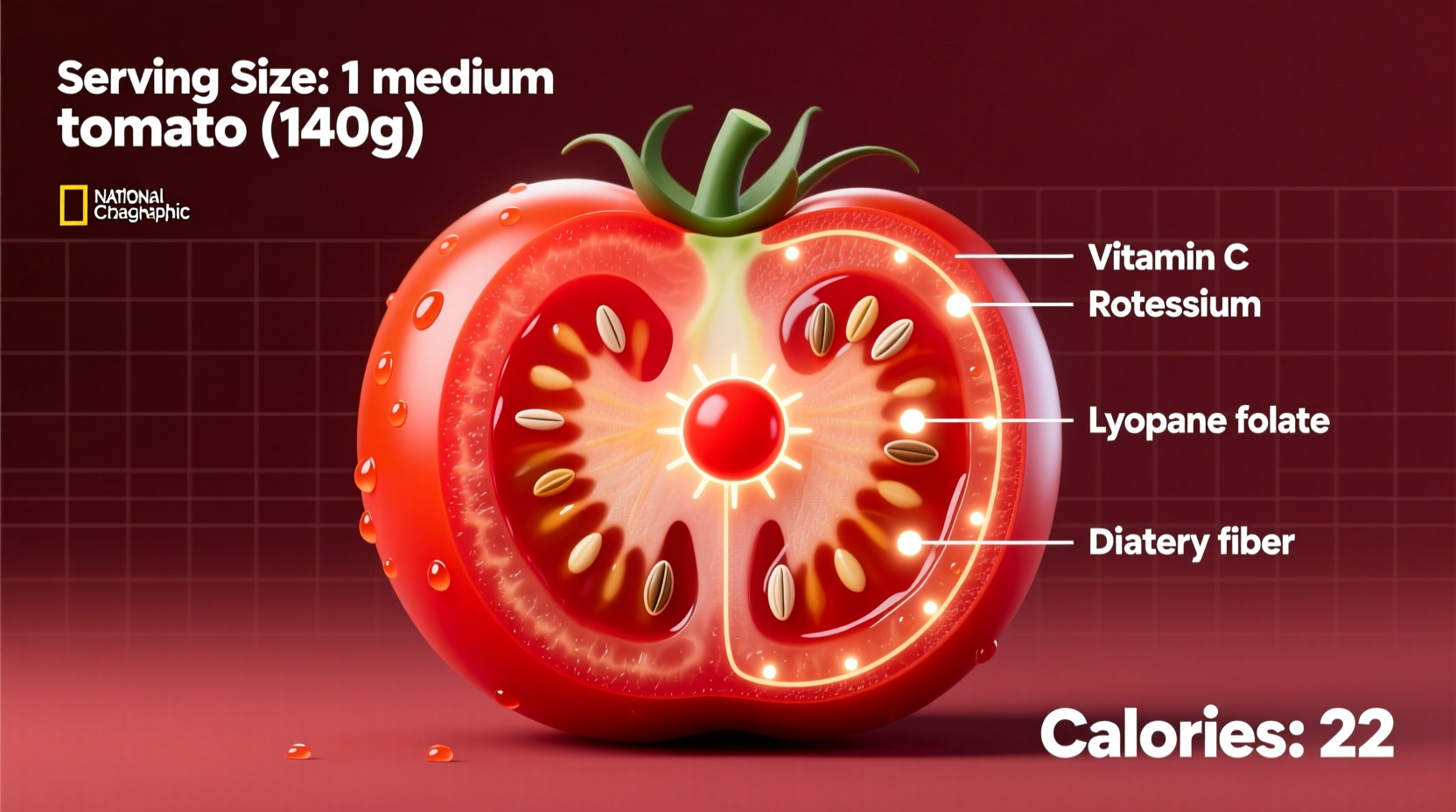Complete Tomato Nutrition Profile: What's Inside Your Favorite Fruit
Despite being commonly treated as a vegetable, tomatoes are technically fruits packed with scientifically-proven health benefits. Understanding their complete nutritional composition helps you maximize the health advantages they offer. Let's explore what makes tomatoes a nutritional powerhouse.
Essential Nutrients in Every Bite
Tomatoes contain a remarkable array of vitamins, minerals, and phytochemicals that work synergistically to promote health. The nutritional value of tomatoes extends far beyond basic vitamins, with compounds that become more bioavailable through proper preparation.
| Nutrient | Per 100g Raw Tomato | % Daily Value | Per Medium Tomato (123g) |
|---|---|---|---|
| Calories | 18 kcal | 1% | 22 kcal |
| Carbohydrates | 3.9 g | 1% | 4.8 g |
| Fiber | 1.2 g | 4% | 1.5 g |
| Vitamin C | 14 mg | 23% | 17 mg |
| Vitamin A | 833 IU | 17% | 1,025 IU |
| Potassium | 237 mg | 7% | 292 mg |
| Lycopene | 2,573 mcg | - | 3,165 mcg |
Data sourced from USDA FoodData Central, reflecting standard raw tomato nutrition facts. These values represent the baseline nutritional content before considering preparation methods that can enhance certain nutrients.
Raw vs. Cooked: How Preparation Affects Tomato Nutrition Info
One of the most fascinating aspects of tomato nutritional value is how preparation methods significantly impact nutrient availability. While raw tomatoes preserve vitamin C content, cooking dramatically increases lycopene bioavailability:
- Raw tomatoes: Highest vitamin C retention (heat-sensitive)
- Cooked tomatoes: Lycopene becomes 2.5-3x more bioavailable when heated
- With healthy fats: Adding olive oil increases carotenoid absorption by 4x
- Processed products: Tomato paste contains up to 10x more concentrated lycopene than raw tomatoes
This preparation-dependent nutrient variation explains why both raw and cooked tomatoes should be part of a balanced diet to maximize comprehensive tomato nutrition benefits.

Science-Backed Health Benefits of Tomato Consumption
The impressive tomato nutritional profile translates to measurable health advantages supported by extensive research:
Heart Health Protection
Lycopene in tomatoes reduces oxidative stress and inflammation markers associated with cardiovascular disease. A American Heart Association-reviewed study found that regular tomato consumption correlates with 17% lower risk of heart disease. The potassium content also helps regulate blood pressure.
Cancer Prevention Properties
Research published in Cancer Epidemiology, Biomarkers & Prevention shows that lycopene's antioxidant properties may reduce prostate cancer risk by up to 26%. The combination of vitamin C, beta-carotene, and lycopene creates a powerful antioxidant network that protects cells from DNA damage.
Skin Health and Protection
Regular tomato consumption provides natural photoprotection. A study in the Journal of Nutrition demonstrated that participants consuming 40g of tomato paste daily with olive oil showed 40% less skin redness after UV exposure compared to the control group. This effect builds over 10-12 weeks of consistent consumption.
Tomato Varieties: Nutritional Differences You Should Know
Not all tomatoes deliver identical nutritional benefits. Different varieties offer unique nutrient profiles:
- Cherry tomatoes: Higher sugar content but also 20% more vitamin C than standard varieties
- Roma tomatoes: Concentrated lycopene levels (up to 50% more than round tomatoes)
- Yellow tomatoes: Rich in beta-cryptoxanthin (supports lung health) but lower in lycopene
- Heirloom varieties: Often contain unique phytonutrient combinations not found in commercial hybrids
Maximizing Tomato Nutrition: Practical Tips for Daily Consumption
Understanding tomato nutritional value is only half the equation—you need practical strategies to incorporate these benefits into your daily routine:
Optimal Daily Intake Recommendations
For significant health benefits, aim for:
- At least 10,000 mcg of lycopene daily (equivalent to 1 cup tomato sauce or 2 medium raw tomatoes)
- Daily consumption rather than occasional large servings (nutrients build in your system)
- Variety in preparation methods to access different nutrient profiles
Smart Pairing Strategies
Enhance nutrient absorption with these evidence-based combinations:
- Tomatoes + olive oil: Increases lycopene absorption by 300-400%
- Tomatoes + black pepper: Enhances antioxidant activity of carotenoids
- Tomatoes + healthy fats: Avocado or nuts improve fat-soluble nutrient uptake
Avoid These Common Mistakes
Don't undermine tomato nutrition benefits with these preparation errors:
- Overcooking (destroys vitamin C while only moderately increasing lycopene)
- Consuming without healthy fats (limits lycopene absorption)
- Storing at room temperature for extended periods (reduces vitamin content)
- Washing after cutting (leaches water-soluble vitamins)
Special Considerations and Context Boundaries
While tomatoes offer exceptional nutritional value, certain contexts affect their benefits:
- Acid sensitivity: Those with GERD may need to limit tomato consumption despite nutritional benefits
- Medication interactions: High potassium content requires monitoring for those on ACE inhibitors
- Nightshade sensitivity: A small percentage of people experience inflammation from nightshade vegetables
- Seasonal variation: Vine-ripened summer tomatoes contain up to 50% more lycopene than greenhouse winter varieties
Understanding these context boundaries ensures you can safely incorporate tomatoes into your diet while maximizing their nutritional advantages.
Tomato Nutrition Through the Seasons: Preservation Impact
The nutritional value of tomatoes changes based on how they're preserved:
- Fresh, vine-ripened: Highest vitamin C content but lower lycopene bioavailability
- Canned tomatoes: Increased lycopene (up to 25% higher than fresh) but some vitamin C loss
- Sun-dried: Concentrated nutrients but higher sodium content in commercial products
- Tomato juice: Convenient source but often contains added sodium (check labels)
For optimal year-round nutrition, combine fresh summer tomatoes with properly stored winter alternatives to maintain consistent nutrient intake.











 浙公网安备
33010002000092号
浙公网安备
33010002000092号 浙B2-20120091-4
浙B2-20120091-4